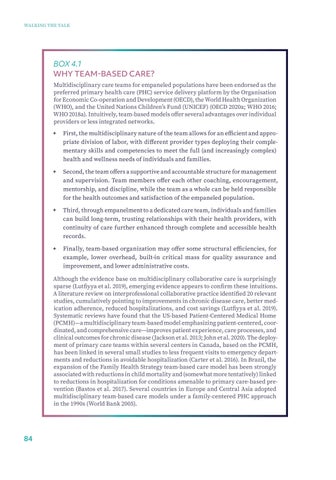WALKING THE TALK
BOX 4.1 WHY TEAM-BASED CARE? Multidisciplinary care teams for empaneled populations have been endorsed as the preferred primary health care (PHC) service delivery platform by the Organisation for Economic Co-operation and Development (OECD), the World Health Organization (WHO), and the United Nations Children’s Fund (UNICEF) (OECD 2020a; WHO 2016; WHO 2018a). Intuitively, team-based models offer several advantages over individual providers or less integrated networks. ++ First, the multidisciplinary nature of the team allows for an efficient and appropriate division of labor, with different provider types deploying their complementary skills and competencies to meet the full (and increasingly complex) health and wellness needs of individuals and families. ++ Second, the team offers a supportive and accountable structure for management and supervision. Team members offer each other coaching, encouragement, mentorship, and discipline, while the team as a whole can be held responsible for the health outcomes and satisfaction of the empaneled population. ++ Third, through empanelment to a dedicated care team, individuals and families can build long-term, trusting relationships with their health providers, with continuity of care further enhanced through complete and accessible health records. ++ Finally, team-based organization may offer some structural efficiencies, for example, lower overhead, built-in critical mass for quality assurance and improvement, and lower administrative costs. Although the evidence base on multidisciplinary collaborative care is surprisingly sparse (Lutfiyya et al. 2019), emerging evidence appears to confirm these intuitions. A literature review on interprofessional collaborative practice identified 20 relevant studies, cumulatively pointing to improvements in chronic disease care, better medication adherence, reduced hospitalizations, and cost savings (Lutfiyya et al. 2019). Systematic reviews have found that the US-based Patient-Centered Medical Home (PCMH)—a multidisciplinary team-based model emphasizing patient-centered, coordinated, and comprehensive care—improves patient experience, care processes, and clinical outcomes for chronic disease (Jackson et al. 2013; John et al. 2020). The deployment of primary care teams within several centers in Canada, based on the PCMH, has been linked in several small studies to less frequent visits to emergency departments and reductions in avoidable hospitalization (Carter et al. 2016). In Brazil, the expansion of the Family Health Strategy team-based care model has been strongly associated with reductions in child mortality and (somewhat more tentatively) linked to reductions in hospitalization for conditions amenable to primary care-based prevention (Bastos et al. 2017). Several countries in Europe and Central Asia adopted multidisciplinary team-based care models under a family-centered PHC approach in the 1990s (World Bank 2005).
84


